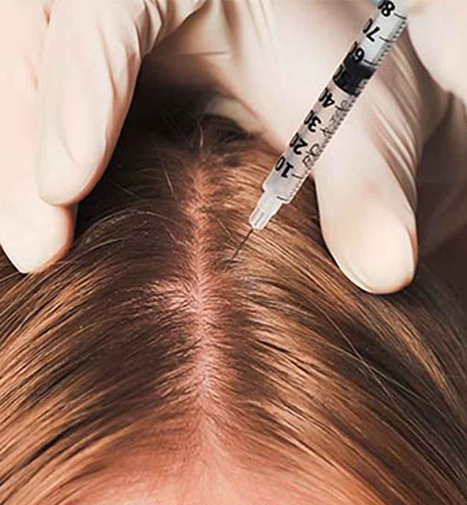In a world where life pressures are running at maximum, we offer many services to help you Relax, Refresh and Renew for A More Beautiful You!
-
Hair Transplant
-
Botox
-
Dermal Fillers
-
PRP
-
Mesotherapy
HAIR LOSS MALES VS FEMALES
From the day the person is born throughout the early development stages -‐ daily routines, lifestyle patterns and eating habits typically contribute to hair loss and scalp disorders among both men and women. Pattern hair loss is a genetic condition that progresses with age, it occurs in hair follicular located in the front, top and crown areas of the scalp, while the hair and scalp type is the factor that determines how quickly baldness occurs. Androgenetic alopecia or male pattern hair loss (MPHL) is the most common type of hair loss in men, usually as a result of the male hormone Dihydrotestosterone (DHT) on a genetically susceptible scalp. It can happen anytime between late teenage years till early 50s, mostly expected among those who have male relatives with the same condition. Possible causes and common conditions of hair loss among women are more complex. There are medical factors as well as genetic transmission for hair thinning. As is the case with men, androgenic alopecia is the main cause of hair loss that affects 2/3 of women, but it rarely results in total baldness. Primary reasons for hair thinning or shedding could be simple or temporary. Multiple medical conditions vary in each case depending on the problem. From pregnancy and physical stress to hormonal imbalances like with Hyperthyroidism and Hypoestrogenism, to minerals and vitamin deficiencies, most commonly low iron levels and lack of protein and magnesium. Depending on the case, the key to successful results is diagnosing the condition early enough, and thus to preserve and restore the healthy existing hair.
THERE ARE TWO METHODS OF HAIR TRANSPLANTATION :
FUT (FOLLICULAR UNITS TRANSPLANTATION) :
Is removing thin strip of hair behind the head. This hair is genetically programmed to grow hair throughout your lifetime. This strip is then sectioned into small grafts (micro grafts and one hair or follicular units) that are transplanted to bald or thinning areas of the head. This operation is done under local anesthesia. It lasts 4-5 hours. This transplant hair will be last all life time and will grow 1 cm per month and it doesn't need any special care after the operation. You can go to work two days after the operation. You can begin shampooing your hair two days after the operation.
FUE (FOLLICULAR UNITS EXTRACTION) :
Harvesting individual Follicular Units are extracted directly from the hair restoration patient's donor area, ideally one at a time. In FUE method we can harvest Follicules from areas outside the head such as : Chest, legs, arms, abdomen, back , face and beard. We are using FUE method mainly in hair transplantation.
FUT VS FUE. METHODS, PROCEDURES & RECOVERY
There are two methods for hair transplantation and permanent hair restoration. FUT (FOLLICULAR UNIT TRANSPLANTATION) This method is genetically formulated to grow hair throughout a lifetime. FUT Transplantation is a surgical operation that takes four to five hours under local anesthesia, whereas a thin strip of tissue is removed from the back or the sides of the head, then sectioned into micro grafts and transplanted in bald or thinning areas to allow hair restoration. The hair is expected to grow 1 cm per month, while the procedure doesn’t require any special care or precautions. The patient can proceed with shampooing the next day and resume daily duties after a few days. FUE (FOLLICULAR UNIT EXTRACTION) This method is the recommended hair transplantation technique and the one used at MHC. FUE Transplantation is a minimally invasive operation in which each follicular unit (follicles) is individually harvested from other body areas to the scalp. The chest, arms, legs, abdomen, back or face are possible donor areas to extract the hair to be restored on the head. The patient is expected to resume daily activities directly after the operation. It’s normal for the transplanted hair to fall out two to three weeks after the procedure and 60 percent new hair growth is expected six to nine months after the surgery.
MORE INFO
Beard hair transplants are typically performed on men who have no beard and/or moustaches or on men who have spotty or patchy areas in their beards and/or moustaches. For many men a beard is a fashion statement, while for others, a beard may hide acne scars or help de-emphasize (or emphasize) certain facial features. Men with small or recessed chins will sometimes use a beard to enhance their features. The beard transplant procedure typically takes from 4 to 6 hours to complete. During this time, hairs are harvested from the donor site in the back of the head. The hair seeds are then placed in the thinning or patchy areas of the beard. Because of the overabundance of permanent hairs in the donor area, this hair is typically not missed.
Are you having trouble growing a proper beard? A full thick beard is a sure sign of masculinity.
...Eyebrows are a major facial feature and they make a difference in one's appearance. In addition to protecting the eyes, they frame the face and help us to communicate better with facial expression. Many women suffer with thin or transparent eyebrows from over-plucking, genetic loss through the aging process, or were just born with thin, even non-existent eyebrows. Today, with our modern eyebrow transplants a man or a woman can have thick lush eyebrows in one procedure. Are you tired of masking your thin, uneven, or ill-shapen brows? Get ready to do something permanent to finally put an end to the eyebrow pencils, stencils, tattoos and cosmetics...
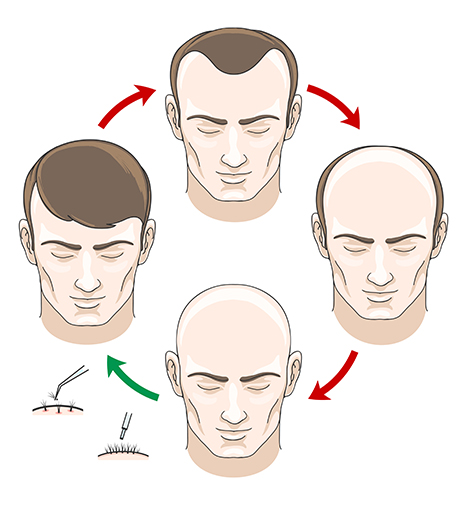
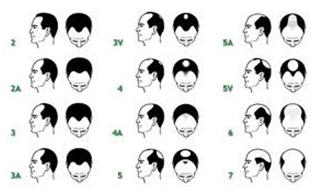
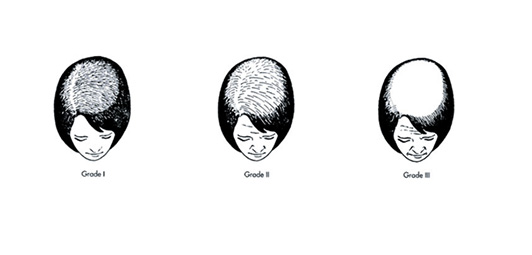
Botox injections are one of the most common cosmetic procedures performed today. The Food and Drug Administration has approved use of the drug — it temporarily remove frown lines and other wrinkles between the brows and across forehead.It also has been approved to relieve uncontrollable tightening of neck muscles and eyelid muscles, to ease crossed eyes, and to control severe underarm sweating.
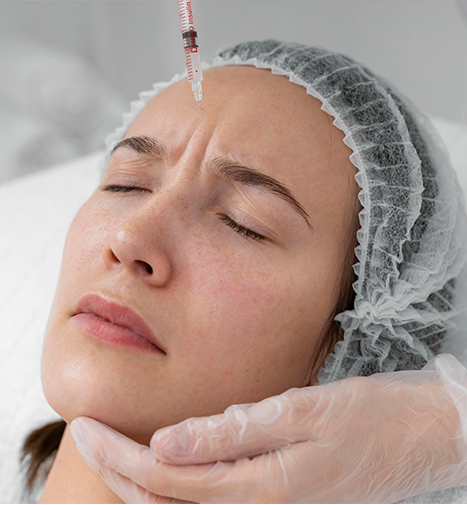
Dermal fillers can restore skin aging by filling in areas of decreased volume caused by age, smoking, gravity and sun.Dermal fillers are used to fill in lines and hollowness around the face. There are many different types of fillers available, each of them having great safety and tolerability profiles. With a careful examination of your skin and “problem areas” we can help you choose the best filler for your needs.
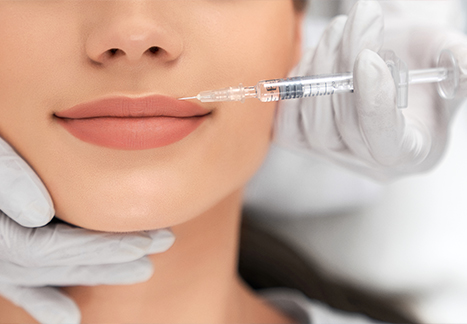
What is PRP?
PRP stands for platelet-rich plasma, a high concentration of platelets in a small volume of plasma derived from one’s own blood. The platelets within PRP contain hundreds of proteins called growth factors, which in turn are responsible for the medical benefits of PRP. Because it contains only components of one’s own blood there is virtually no risk of an allergic reaction or disease transmission with PRP therapy making it one of the safest cosmetic procedures performed today.
PRP FOR HAIR RESTORATION
PRP treatment for hair loss can provide natural looking results without the need for a costly, invasive surgical procedure.PRP therapy can successfully minimize hair loss. The nutrient-rich plasma rejuvenates aging follicular and can reinvigorate thinning areas of the scalp to produce thicker hair. While PRP therapy cannot completely revive bald spots or rebuild hairlines, it can make a marked improvement in hair density and overall coverage, especially for patients with diffused hair loss.
In addition to combating hair loss, PRP therapy can be used to supplement hair transplants and accelerating new hair growth.
PRP For Face
PRP For Face is a nonsurgical procedure that is customized to an individual. The process entails the reinjection of PRP into areas of the face in order to reduce wrinkles and facilitate facial rejuvenation for a firmer and younger skin.
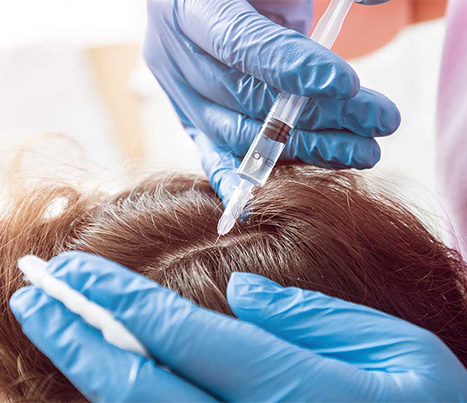
Hair Mesotherapy
What Is Hair Mesotherapy and How Is It Applied?
Hair Mesotherapy is the direct injection of vitamins, minerals (Calcium, Iodine, Manganese, Copper, Zinc, Selenium, Iron, Potassium), agents related to the keratin layer of the skin, amino acids and surface expanders required for hair growth and development into the scalp.
Mesotherapy is very effective for scalp and hair. It is considered one of the most popular applications in modern cosmetology in combating various hair problems.
Hair Mesotherapy
Hair Mesotherapy is a treatment method applied by injecting the vitamins, minerals and amino acid mixtures required for the hair into the scalp.
This method enables the components that nourish the hair follicular to settle in the hair easily. With this method, hair loss can be treated, as it thickens thinned hair, stops hair loss, and makes the hair stronger and shinier.
The method of mesotherapy is based on the stimulation of the skin's fibroblasts through multiple needle punctures and then the injection of regenerative and antioxidant substances into the skin. The substances used include hyaluronic acid, vitamins A, E, C, antioxidant enzymes, amino acids, minerals, drugs, fat-dissolving and firming agents (eg in the treatment of cellulite). The depth of the infusion ranges from 0.15mm to 2.5mm depending on the problem being treated. Mesotherapy finds many applications. Its two main applications are aimed at improving the texture of facial skin and treating cellulite. Mesotherapy is also applied to stretch marks, hair loss, wrinkle correction and thinning of facial lines. Finally, it is used with spectacular results in many cases of hyperpigmentation and in
Indications of Hair Mesotherapy:
Excessive hair loss
Seborrhea of the scalp associated with the breakdown of sebaceous glands;
Dandruff
Scratched and dry scalp
Increased hair fragility and split hair
Volume loss in basal area
Mesotherapy with Dermapen
antioxidant substances into the skin. The substances used include hyaluronic acid, vitamins A, E, C, antioxidant enzymes, amino acids, minerals, drugs, fat-dissolving and firming agents (eg in the treatment of cellulite). The depth of the infusion ranges from 0.15mm to 2.5mm depending on the problem being treated. Mesotherapy finds many applications. Its two main applications are aimed at improving the texture of facial skin and treating cellulite. Mesotherapy is also applied to stretch marks, hair loss, wrinkle correction and thinning of facial lines. Finally, it is used with spectacular results in many cases of hyperpigmentation and in combination with other treatments, such as microdermabrasion, it has impressive and long-term results. In our private practice the application of mesotherapy is done with the Dermapen Dr. Pen.
